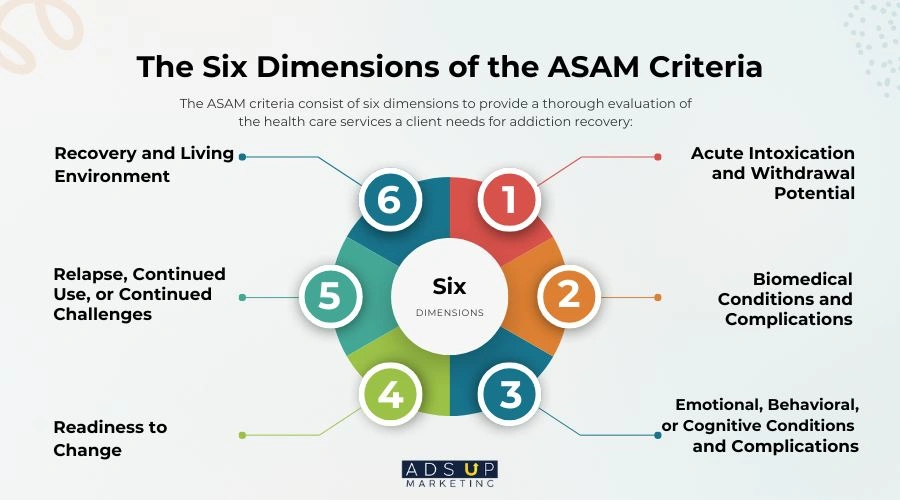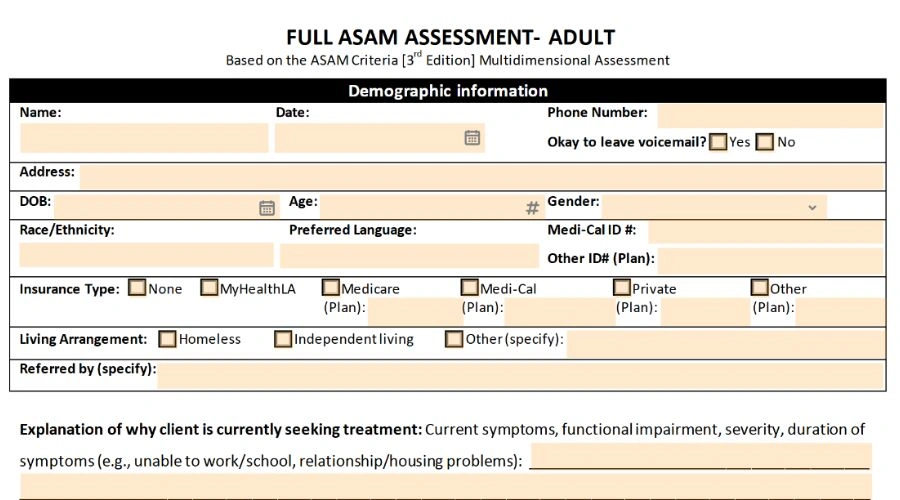Ensure an Accurate ASAM Assessment is Written for Each Client
When providing care for clients with a substance use disorder, guaranteed accuracy for the ASAM criteria assessment (American Society of Addiction Medicine) is a crucial component of the addiction treatment community.
This evaluation allows addiction treatment providers to accurately evaluate various elements of substance use disorder to craft the most effective individualized treatment plan.
In this article, we unpack the ASAM criteria and include a printable PDF of an ASAM assessment example to assist any addiction treatment resource provider in assessing patient needs. This ensures that each client receives the correct treatment services by empowering facility staff to develop treatment plans that cater to each substance use disorder case.
What Is the Correct ASAM Criteria?
ASAM criteria is a set of guidelines used by substance use disorder professionals to determine treatment plans based on patient assessments. These guidelines consider six dimensions of a client’s life, ensuring their addiction medicine and recovery needs are met with the most efficient care level and treatment delivery.
The correct ASAM criteria help treatment providers make more educated decisions about clinical contexts. These include the patient’s risks, whether detox is required, and whether to opt for an inpatient, outpatient, or other specialized treatment program.
The Six Dimensions of the ASAM Criteria

The ASAM criteria consist of six dimensions to provide a thorough evaluation of the health care services a client needs for addiction recovery:
Acute Intoxication and Withdrawal Potential
- Evaluate the client’s risk of withdrawal.
- The assessment determines whether substance detoxification is required.
Biomedical Conditions and Complications
- Determine if any physical health challenges may impact treatment services.
- Considers any chronic conditions, pregnancy, recent surgeries, or significant treatment that has been administered.
Emotional, Behavioral, or Cognitive Conditions and Complications
- Treatment recommendations and screening for co-occurring conditions that include mental health challenges.
- Evaluates cognitive impairments that may create difficulties during treatment.
Readiness to Change
- This empowers substance use managed care providers to gauge the client’s motivation to begin patient-centered care.
- The client’s potential roadblocks to recovery are measured and identified.
Relapse, Continued Use, or Continued Challenges
- Measures active participants in treatment, their prior relapse history, and current risk factors.
- This part of the guide enhances the medical provider’s develop relapse prevention plans.
Recovery and Living Environment
- This measures patients’ home life, including ongoing social support structures and potential stress factors.
- This gives clinicians an idea of whether environmental transitions are necessary for successful treatment duration.
A Completed ASAM Assessment Example
Below, we’ve compiled a real-time example of an ASAM Assessment to help better familiarize managed care organizations with an accurate measure of a completed questionnaire:
Case Study: John D., a 43-Year-Old Male with Alcohol Use Disorder
- Dimension 1: Acute Intoxication and Withdrawal Potential
John has been drinking daily for the past 15 years and experiences tremors, sweating, and DTs when he stops drinking. Past criteria strongly recommend medically supervised detox. - Dimension 2: Biomedical Conditions and Complications
The client has high blood pressure and was recently hospitalized for liver enzyme abnormalities. A medical consultation with a primary care or specialist is recommended along with treatment. - Dimension 3: Emotional, Behavioral, or Cognitive Conditions and Complications
John has been clinically diagnosed with depression and was prescribed antidepressants, which he inconsistently takes. He requires dual-diagnosis treatment to treat both challenges simultaneously. - Dimension 4: Readiness to Change
Although John acknowledges his drinking problem, he is uncertain about quitting. Motivational interviewing may be beneficial for this independent assessment. - Dimension 5: Relapse, Continued Use, or Continued Problem Potential
John has relapsed on multiple occasions in the past. His triggers include work stress, social pressure, financial challenges, and disagreements with his significant other. - Dimension 6: Recovery/Living Environment
John lives with a companion who also drinks heavily. His home environment is not supportive of recovery, and a sober living arrangement is recommended to facilitate continuity of care.
Common Mistakes to Avoid in Writing Up ASAM Assessments

Writing an ASAM assessment requires meticulous attention to detail. To help craft the most efficient treatment options, avoid these common mistakes:
- Ensure you include complete documentation of all required information. Provide specific details regarding the client’s condition and care level needs.
- Avoid recommending an incorrect care level. If the care level doesn’t match the guidelines outlined by the assessment, the client could fail to receive the proper therapeutic modalities required for long-term recovery.
- Don’t ignore co-occurring disorders. It’s common for practitioners to focus on the substance abuse challenges and fail to give any mental health challenges the proper attention. Ensure you address both the addiction and any mental health disorders at the center of the substance abuse issues.
- Be mindful of their willingness to change. Anyone can be forced or coaxed into treatment. However, if the treatment plan doesn’t match their documented level of motivation, typically, the result is relapse due to a lack of the proper type of personalized care plan.
Ensuring an Accurate ASAM Assessment
If your goal is to improve the accuracy of your ASAM assessments, your staff should be mindful of the following:
- Ensure interviews are in-depth enough to gather a detailed level of information. Without diving deep enough into client research, it becomes difficult to administer the proper care level and treatment plan.
- Always use evidence-based screening tools when measuring risks for withdrawal and any mental health challenges.
- It’s never a bad idea to work with a multi-departmental care team, including doctors, therapists, and even case workers. Additional professional recommendations can help bolster your client’s quality of care.
- As clients progress through treatment, always return to the assessments to update relevant information when progress or setbacks occur.
Printable ASAM Assessment

For ease of use, staff practice, and general familiarity, we’ve included a downloadable link for a PDF file that contains a copy of an ASAM assessment. Encourage your team to get familiar with conducting these interviews, giving them time to practice on client profiles until they’re comfortable with efficiently completing the process.
For your downloadable PDF file, click here and print your own copy for educational purposes.
Variations of the Assessment
There are several versions of the ASAM assessment, each with minor changes in how information is obtained regarding specific client dynamics. You can even develop your version of the evaluation, assuming that it adheres to the criteria set forth by the American Society of Addiction Medicine.
If you’d like to increase the intensity of your treatment, consider adding additional diagnostic criteria or forming extra sets of questions to help you plan more efficiently for client admission.
Don’t Ignore the Importance of the ASAM Assessment
The ASAM assessment is a mandatory tool in administering efficient, complete services for long-term recovery. We can’t state enough the importance of gathering a detailed analysis of each client and making decisions on a case-by-case basis to offer personalized care.
Ads Up Marketing can help with any questions or concerns regarding this assessment.
To leverage our services, reach out to a team member today, and we will assist you with all aspects of facilities’ Admissions and operations to support lower CPA’s and raise revenues.
Free Digital Marketing Analysis

